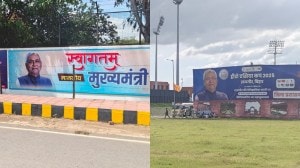Two neighbouring cities of Delhi — Noida and Gurgaon — have a different story to tell each time it rains heavily in the National Capital Region (NCR).

Noida, the other suburban city in the NCR, however, sees fewer instances of waterlogging and traffic snarls in such situations. The city was established in 1975 during the Emergency when Sanjay Gandhi, son of then Prime Minister Indira Gandhi, wanted to move industries out of the national capital.
Story continues below this ad
Governed by the New Okhla Industrial Development Authority (NOIDA), Noida, which has eventually been pitched as the state’s economic powerhouse, was developed under the Uttar Pradesh Industrial Area Development Act, 1976, as an industrial township.
Experts say that Noida was a planned “greenfield” city, developed on entirely new, undeveloped land. Infrastructure, like roads, sewers, drain pipes, footpaths and streetlights, was laid out after the land was acquired all at once by the development authority, according to PSN Rao, Professor of Housing, School of Planning and Architecture, Delhi.
 Commuters make their way through a waterlogged road amid rainfall, in Gurugram, Monday. (PTI)
Commuters make their way through a waterlogged road amid rainfall, in Gurugram, Monday. (PTI)
It was then that the private developers came into the picture and plugged into the common infrastructure.
Nearly half a century back, the acquired land comprised 50 villages and having a total area of 14,915 hectare (36,841 acres). Currently, it covers 81 villages and a total of about 20,316 hectares of land.
Story continues below this ad
“Proper planning was done for Noida and thus, a drainage and road network proportionate to the built infrastructure was built,” says Mukta Naik, an urban researcher formerly with the National Institute of Urban Affairs and the Centre for Policy Research.
“Gurgaon, on the other hand, was developed in a public private partnership (PPP) mode,” Rao points out as he explains how land parcels of different sizes and shapes at various locations were acquired and developed by private developers, most prominent among them being DLF.
“While the external infrastructure was developed by the state government, internal infrastructure was not linked to it properly,” he adds.
The Indian Express previously reported that the Haryana government — from the 1970s onwards — introduced a series of laws, which enabled private firms to acquire land on a large scale to develop townships. Land acquisition was not carried out in a uniform manner. This led to irregular plots, and roads that led to nowhere.
Story continues below this ad
The Aravalli ridge, on the southern edge of Gurgaon, is the natural high ground for the city, the report pointed out. From there, the land slopes down towards the north, which is at a lower altitude. Rainwater in Gurgaon thus flows mainly from the south to the north, towards the Najafgarh Jheel in West Delhi. The natural drainage channels have disappeared now, and haphazard urban expansion has not kept the city’s topographic reality in mind, according to experts.
Gurgaon’s road network is also believed to accentuate the problem. The lack of a clear road grid leads to further congestion, which puts the spotlight on waterlogging, according to Naik.


 Commuters make their way through a waterlogged road amid rainfall, in Gurugram, Monday. (PTI)
Commuters make their way through a waterlogged road amid rainfall, in Gurugram, Monday. (PTI)






